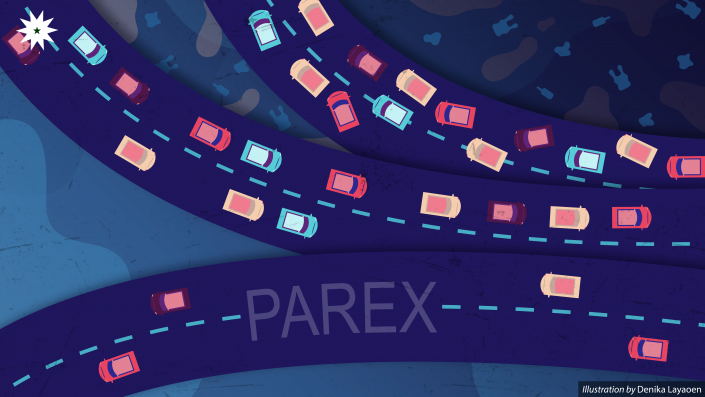The National Capital Region has been in lockdown for over a year, yet somehow it sits at fourth place as the world’s most congested city. Authorities have been building new highways in a bid to accommodate the increasingly heavy traffic in Metro Manila. But the problem only continues to grow worse every year—that is, travel times are longer and commuting becomes more uncomfortable, if not a nuance.
Proposed over a year ago as a bid to address Metro Manila traffic, the Pasig River Expressway (PAREX) project—a P95-billion build-operate-transfer tollway project solely funded and built by San Miguel Corporation (SMC)—was approved by the Department of Public Works and Highways (DPWH), Toll Regulatory Board (TRB), and the Department of Transportation (DOTr) last September 21 despite protests from various environmental, historical, and transport groups.
PAREX is a 19.4-kilometer, six-lane, elevated expressway to be built along the riverbank of Pasig River, stretching from Radial Road 10 in Manila to Circumferential Road 6 in Taguig, while connecting to Southeast Metro Manila Expressway (SEMME). SMC targets the construction to start in the first quarter of 2022 after having its groundbreaking last September 24—only a few days after its approval—and would be completed on or before 2027.

Commuter’s choice
Political Science and Development Studies Asst. Prof. Allen Surla suggests that more alternative routes must be created to decongest traffic in the eastern part of Metro Manila. However, the Metro does not have enough space to set up “at-grade” roads or roads that are built directly on the ground, and tunneling is much more expensive and dangerous than an elevated highway.
Surla adds that the population in Metro Manila expanded a lot through the years, at least during the daytime. He points out that more people go to the Metro to work then commute home to nearby cities and provinces in the east, north, and south because of expensive rental rates. In effect, commuting becomes in demand, making it the cheaper option.
Furthermore, the current number of public transport vehicles like light rail transit (LRT) lines, buses, and jeepneys, are not enough to accommodate the needs of the commuters in the Metro. Adding more of these public transport vehicles without additional roads could further congest the area. An additional LRT line would be very difficult to build, as procuring rights of way would make the construction longer and a lot more expensive.
On the contrary, Move as One Coalition Secretariat and former Customs Commissioner Sunny Sevilla says that there are other ways to improve public transport without adding roads, citing the new EDSA Carousel that separates buses in their own lane away from normal traffic. “The EDSA Busway really improved things because you don’t have those buses stuck in traffic anymore. And that was done without building an expressway. That was done by using existing space,” he shares.
According to Ramon Ang of SMC, PAREX will have bicycle lanes, walkways, and a bus rapid transit (BRT) system, which will be “beneficial” to commuters. However, Paulo Alcazaren, principal architect of environmental and urban design firm PGAA Creative Design, says that the details for this design have not been made public yet and transport experts question the viability of a BRT system in an elevated setting. For this to be possible, the construction would have an “extensive pedestrian access” to BRT terminals. This would mean, Alcazaren adds, that pedestrians would have to walk up to at least five stories above the ground to these central terminals, and its walkways would have to be connected to the river banks on both sides.
Public over private?
Ang defends the project, however, saying that what critics call “induced demand” will still exist whether PAREX is constructed or not.
“It is not expressways that induce people to buy more cars. It is poor or insufficient public transportation, pollution, and even personal progress of people,” he pushes. The construction of PAREX will lessen traffic and pollution as it will be an “efficient, multi-purpose, and future-ready infrastructure,” Ang maintains.
“Well, he is right about ‘insufficient public transport,’” says Alcazaren.
To opposers of the proposed expressway, the project merely tries to address a symptom of a much bigger problem: bad public transport.
Without fixing public transportation, private cars will only grow in number as roads will also increase and traffic will continue, Alcazaren and other critics counter, calling this phenomenon “induced demand”.
“The more you provide roads, the more traffic it will induce,” the architect explains, adding that simply redirecting traffic will not mitigate anything. “It is like trying to solve gluttony by loosening one’s belt.”
Limiting car ownership is only one way to solve the traffic problem, Surla opines. “People are able to buy cars even if they don’t have parking…that’s why parking is a problem, we also park on the streets.” The abundance in cars, Sevilla explains, is because of car ownership being “the middle class dream of every Metro Manila resident.”
The former commissioner adds, “Bakit [nila] gustong magka-kotse? ‘Para di na ako sasakay sa mga b——- na jeep na ‘yan—mausok, ma-traffic. Ang tagal kong maghihintay, hindi ko alam kung saan ako sasakay, palaging punuan.”
(Why would they want to own a car? “So I won’t have to ride those jeepneys—they’re polluted, traffic is bad, waiting takes too long. I wouldn’t know where to get a ride, and they’re always full.”)
Adding alternative routes may redirect some existing traffic, but only for the benefit of less than 20 percent of Metro Manila’s population who owns cars, both Alcazaren and Sevilla point out.
“We’re looking at this from the point of view, not of car owners or of the wealthy who can afford to pay the toll, but [of] everybody else,” says Sevilla, adding that it is more important to help those without cars by focusing on mass transit.
“Traffic is not the problem. Traffic is a symptom of the problem…[which] is bad public transport,” Sevilla argues. “If we don’t solve public transport, then we give up on solving traffic.”
